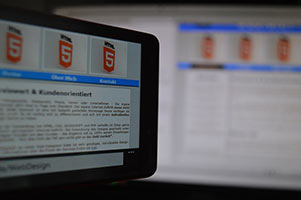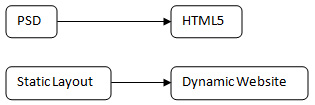Convert PSD to HTML5 Website for your Company

The purpose of having a website is to reach anyone (customers), anytime, and anywhere. So even if your company is closed for the day, your business will be open 24X7 for your customers.
What is PSD to HTML5?
A web page which is designed in a Photoshop document (PSD) is later converted to code via HTML, CSS, and JavaScript.
Why the conversion?
To make web design coding more responsive and fluid for creating highly interactive websites. Here instead of the word ‘why’, it would have been more meaningful if the question was posed about the purpose of designing in Photoshop.
The development of a website always starts with the designing process. PSD, a Photoshop document initiates the design part.
To get that final picture of a website, designers create high-fidelity mockups in Photoshop and will send these designs to website developers who will do with the coding.
Benefits of PSD to HTML5 Conversion
- W3C COMPLAINT
- For websites to provide consistent rich interactive experiences across multiple browsers, they should follow W3C standards.
- Websites developed under the PSD to HTML5 workflow will meet every rule set under W3C validation.
- The benefits of W3C Validation
- i. It optimizes the search engine rankings
- ii. Improved user-experience across multiple-browsers
- iii. Improves accessibility across multiple devices
- HIGH VISIBILITY
- Sometimes even with best technology and good visual hierarchy, websites fail to rank in search engines, do you know why? Also, they say HTML5 is very powerful, why?
- For the first question, here is the answer, search engine bots love to crawl and index websites that are understandable, simple, relevant, and user-friendly. So, any website that doesn’t have these factors is bound to fail in search engines.
- Now for the second question, HTML5
- i. Allows replacing div tags with semantic HTML5 elements for cleaner code structure
- ii. Allows indexing multimedia content (audio, video, and menus)
- iii. Considered a mobile-ready tool for developing mobile websites and applications
- iv. Supports rich-media elements (you can say no to plugin tags)
- v. Ensures better web page loading speed via offline application cache facility
- Every point here shouts nothing but a better user-experience for customers, which is obviously is what search engines are looking for. So with better syntactical features, your websites will be crawled, indexed and a guaranteed high visible spot in the search engines.
- DYNAMIC FUNCTIONALITY
- See the difference? And the purpose of conversion?
- The word ‘dynamic’ is the future because a dynamic website is
- i. Interactive
- ii. Quick to responsiveness
- iii. Easy to update and
- iv. Offers smooth navigation
- MULTI-BROWSER ACCESSIBILITY
- What can be more joyous when a web developer successfully creates a website that is accessible through multiple browsers?
- So any website that is developed under PSD to HTML5 workflow is easily accessible across all the browsers and that counts from Google Chrome to Opera.
- And one more thing, big or small, HTML5 web pages will easily render with every size of a device.




 +91 8277203000
+91 8277203000
